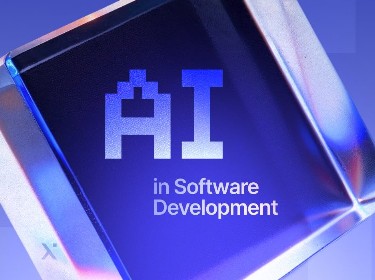Artificial intelligence is transforming the way business is run. Companies talk about AI in the context of digital transformation, process automation, and optimization. For businesses still hesitating, what are the key obstacles? Let’s explore the concept and leave no stone unturned.
The market of AI technologies has reached around $244 billion in 2025, according to Statista. This figure is expected to turn into $800 billion by 2030. Such staggering growth proves the worthiness of integrating AI tools into business processes. Yet, as McKinsey reports, only 1% of companies undergoing digital transformation have reached a mature level of adoption. We’re only in the beginning of the AI era, and it will take time to fully realize its potential and assess the results.
At PixelPlex, we have been dealing with AI technologies since their emergence. We have discussed the trend with our experts and created this comprehensive guide about the types of AI, its pros and cons, as well as costs and benefits. We invite you to explore the insights together.
Why you can’t afford to ignore AI business integration
![]()
AI is the reality that we live in today. It allows companies to gain a competitive advantage. Reluctance to access generative AI integration services might result in financial losses in the long run due to higher operating costs, missed opportunities in customer relations, and other unpleasant consequences. Let’s look at the benefits of AI business integration in more detail.
Improved efficiency and productivity
AI tools automate routine workflows and reduce manual efforts in such areas as customer service, marketing, accounting, etc. Besides, AI helps to analyze datasets faster and more efficiently, which leads to better decision-making. According to McKinsey research, generative AI might add up to $4.4 trillion annually to businesses in 63 domains researched (marketing, sales, drafting computer code, customer interactions, etc.). This is possible due to the opportunity to free employees for higher-level strategic tasks and reducing the burden of paperwork.
Superior strategic choices
AI saves time by swift data analysis. For instance, The New York Times uses machine learning models and AI tools for scanning images and analyzing hundreds of hours of video footage for their reports and investigations. Businesses also examine various data sources to make well-grounded strategic choices. AI-powered tools uncover patterns and correlations that often escape human notice, leading to better decisions and reduced errors.
Strengthened financial efficiency
AI allows companies to decrease expenses and enhance financial savings in different ways. An example here might be the COIN program that used machine learning to interpret commercial loan agreements of the JPMorgan bank. It saved 360,000 hours of annual human workload. AI development provides businesses with the possibility to automate mundane and labor-intensive activities and cut operational costs.
AI MVP Development: How to Validate Ideas Fast Without Breaking the Budget
AI in Software Development: It's More Than Hype, It's the New Hammer
Taking Advantage of AI in Business to Improve Efficiency
Elevated client service
Virtual assistants and AI agents are available 24/7. They facilitate client interactions by providing customized and streamlined customer help. For instance, businesses might consider custom AI chatbot development for their e-commerce, retail, travel, or other types of services. AI learns conversation patterns, examines consumer behavior, and understands client tastes, actions, and requirements to offer personalized products and increase conversions.
Boosted creativity and novelty
AI stimulates creativity. It allows firms to investigate new concepts and create pioneering solutions. AI business integration might help developers build new products by facilitating testing or code optimization. Marketing departments may use AI to generate new ideas for attracting customers or addressing consumer demands. AI-powered ads catch attention and build brand awareness.
Here’s a table summarizing what your business gains and what it misses with or without the AI integration services.
| Business area | Without AI integration: risks & costs | With AI integration: benefits & outcomes |
| Customer service | High wait times, agent burnout, inconsistent support | 24/7 instant responses, automated ticket routing, reduced agent workload |
| Sales & marketing | Inefficient lead prioritization, missed opportunities, generic campaigns | Personalized content, higher conversion rates, increased customer lifetime value |
| Operations & supply chain | Reactive maintenance, inventory imbalances, delivery delays | Predictive maintenance, optimized inventory, and accurate demand forecasting |
| Finance & accounting | Manual, error-prone data entry and invoice processing | Automated invoice processing and fraud detection |
| Human resources | Time-consuming resume screening, high volume of unqualified candidates | Automated candidate screening and skills-based matching |
Understanding the AI integration landscape: types and tools
![]()
As AI has penetrated all types of industries, the list of possible AI-powered tools is rather long. We have focused here on the most common ones.
Customer-facing AI
Chatbots and virtual assistants appear on numerous sites and are designed to improve customer service and release call center agents for more sophisticated activities. With the help of AI chatbot integration, companies build customer loyalty. Chatbots know how to maintain a natural and polite conversation, they know the answers to the most typical questions, and they may connect a caller with a human expert if the request is a challenging one.
Predictive analytics
In this role, AI is like a proactive IT specialist that monitors digital systems for early signs of trouble. It analyzes real-time operational data, such as server performance metrics and network traffic patterns, and compares this information against historical baselines. If the system detects unusual activity that could indicate a future failure, it automatically alerts the technical team about a potential issue. Predictive analytics allows IT staff to address the root cause early, for instance, by reallocating resources or applying a security patch, before it can escalate into a major outage or a security incident.
Process automation
AI streamlines core business operations by taking over repetitive, rules-based workflows. For example, algorithms can process invoices, manage supply chain orders, or generate standard reports. AI automates similar tasks fast and efficiently.
AI for content & product development
AI software is able to scan and analyze vast amounts of online data and identify emerging trends and popular subjects. By looking through social media networks and forums, AI tools provide businesses with insights into what will resonate with their target audience. Beyond analysis, the technology assists by proposing compelling headlines, drafting article bodies, and automatically generating social media captions. It may also suggest product extension on the basis of the audience’s “pains” or expectations.
Recommendation systems
AI learns customer preferences through navigation history, past transactions, indicated interests, and interaction metrics. AI recommendation systems use that data to offer the most relevant content, items, or services to each individual user. These systems bring users customization, boost sales conversion, elevate the average spending per customer, and enhance user retention.
- Zendesk’s Answer Bot is an AI-powered assistant that uses advanced natural language processing to handle a high volume of typical customer questions. It promotes efficient self-service, often suggesting relevant help articles to users. It integrates directly into a company’s website and mobile apps, ensuring help is always readily available.
- The Coca-Cola company employs AI to automate its massive beverage ordering and distribution system. The technology analyzes sales data to predict inventory needs and manage stock levels across countless locations, ensuring shelves remain full while optimizing logistical efficiency.
- The Associated Press news agency employs AI to automate the generation of thousands of corporate earnings reports each year. By using natural language generation, the system quickly transforms raw financial data into coherent, publication-ready news stories. It has increased the volume of reports the AP publishes, while allowing its reporters to dedicate their expertise to complex feature stories that require deep human understanding.
- Spotify’s Discover Weekly playlist examines a user’s listening habits, favorite genres, and even the audio characteristics of liked songs to identify new, unreleased, or overlooked music that the user will likely enjoy. This functionality keeps users engaged and subscribed, and also promotes music discovery.
AI-powered tools bring benefits to all business functions.
| Business function | AI tool type | Primary benefit |
| Customer service | AI chatbots & virtual assistants | Handles common queries instantly, freeing agents for complex issues |
| IT & operations | Predictive analytics | Prevents system failures and downtime through early alerts |
| Operations & logistics | Process automation | Automates repetitive workflows for speed and efficiency |
| Marketing & product | AI content & trend analysis | Generates content and identifies trends to engage audiences |
| Sales & marketing | Recommendation systems | Boosts sales and loyalty through personalized user suggestions |
The most common AI technologies for business today
![]()
The technologies behind the tools described above are machine learning (ML), deep learning, natural language processing (NLP), and computer vision. There are more, but these form the core of the tools that we know today as “powered with AI.” Such tools help companies improve performance in various business domains.
Machine learning
ML algorithms learn from data. They collect various types of data and, over time, try to identify patterns and make decisions. The more high-quality data they examine, the better outcomes they will demonstrate. ML models can uncover key insights, forecast trends like future sales, and detect anomalies, providing a foundation for data-driven business decisions.
Deep learning
This technology is a branch of ML that uses complex artificial neural networks to process data with minimal human intervention. It is able to extract meaning from unstructured information like text, audio, and images. This makes it the driving force behind advanced applications such as speech recognition, fraud detection, and image analysis.
Natural language processing
This superpower enables your smart devices to hear and understand your speech. NLP powers systems that interact with users through text or voice, enabling functionalities like real-time language translation, intelligent customer service chatbots, and voice-operated GPS systems by deriving insights from unstructured language data.
Computer vision
Modern AI tools can hear, listen, understand, and speak with a human. They can also see. Computer vision allows machines to interpret and derive meaningful information from visual inputs like digital images and videos. In combination with machine learning and deep learning, AI tools identify and classify objects within visual data. Its practical applications are vast, ranging from automated quality control on production lines to enabling the navigation systems of autonomous vehicles.
Here are the business applications of the mentioned AI technologies and their impact.
| AI application | Technology used | Business impact |
| Customer service chatbots | NLP, deep learning | Provides instant, 24/7 customer support, freeing human agents for complex issues |
| Virtual assistants & GPS | NLP, deep learning | Enables voice-operated commands and interactions for hands-free assistance |
| Fraud detection systems | Deep learning | Identifies fraudulent activity by analyzing patterns and anomalies in user behavior |
| Facial recognition | Deep learning, computer vision | Enhances security and enables personalized user experiences through identity verification |
| Quality control & defect detection | Computer vision, ML, deep learning | Visual inspection in manufacturing, identifying minor defects to ensure product quality |
| Sales & demand forecasting | ML | Analyzes data to predict future trends (e.g., sales revenue), supporting better inventory and business planning |
| Anomaly detection in data | ML | Discovers unusual patterns or outliers in large datasets, crucial for security and operational monitoring |
The pros and cons of AI business integration
AI integration consulting and services bring businesses the following benefits:
- Operational automation: AI tackles routine, high-volume duties such as updating records and monitoring stock levels, which results in efficient allocation of effort among staff.
- Accelerated processes: AI is capable of almost instant analysis and performance.
- Strategic planning: Business executives make decisions on the basis of AI analysis of market trends. This helps companies navigate market changes effectively.
- Financial optimization: By minimizing manual labor and associated mistakes, AI integration cuts costs in the workforce, logistics, and inventory.
- Improved risk management and regulation adherence: AI tracks for security threats and suspicious activities. It helps avoid fraud and operational disruptions. It also automates the tracking and analysis of legal documents to ensure obligations are met efficiently.
Here are measurable outcomes of AI integration, supported by research from firms like Gartner, Deloitte, and McKinsey:
| Key benefit | Measurable outcome |
| Operational automation | Reduces manual task time by up to 80% (e.g., invoice processing from 15 minutes to 3). |
| Accelerated processes | Cuts report generation from hours to seconds. |
| Strategic planning | Increases forecast accuracy by up to 25%, identifies new market opportunities 3x faster. |
| Financial optimization | Lowers operational costs by 15-25%, reduces inventory carrying costs by up to 30%. |
| Risk & compliance | Detects fraud 50% faster, automates 90% of compliance reporting, reducing manual review time. |
Every modernization effort carries potential drawbacks that businesses must be aware of:
- High costs: AI app development often demands considerable initial capital for technology acquisition, infrastructure, and upskilling employees.
- Expertise shortage: Many companies lack the in-house AI specialists and data scientists needed for successful implementation and maintenance.
- Data security and privacy risks: AI apps process massive datasets, which might create vulnerabilities, increasing the risk of sensitive data breaches and non-compliance with privacy laws.
- Ethical dilemmas and bias: AI may generate biased outcomes, which will negatively impact your business’s reputation.
- Integration hurdles: Legacy systems might require significant transformation to successfully integrate with AI solutions.
- “Black box” problem: Many complex AI systems function without clear explanations for their conclusions, creating challenges in regulated sectors like finance and healthcare.
Here are the possible ways to address the challenges:
| Potential challenge | How to mitigate it |
| High initial investment | Explore AI-as-a-Service platforms and cloud-based solutions to reduce upfront hardware costs |
| Expertise shortage | Partner with external AI development firms to fill skill gaps |
| Data security & privacy risks | Implement data governance policies, anonymize sensitive information, and use encryption and secure access controls |
| Ethical dilemmas & bias | Use diverse datasets for training. Regularly audit AI decisions for fairness and bias, and employ “Explainable AI” (XAI) tools |
| Integration complexity | Use APIs and middleware, and consider a phased implementation approach to modernize systems gradually |
| “Black box” problem | Prioritize interpretable models in regulated fields. Use XAI techniques to create transparency and build trust with users and regulators. |
Real-world success stories across industries
![]()
Finance
As we’ve mentioned at the beginning of the article, JPMorgan Chase’s COIN program uses AI to interpret commercial loan agreements. It manages to significantly reduce hours of annual legal work. Another example is an American hedge fund, Medallion Fund. It is managed by Renaissance Technologies. It employs AI and complex quantitative models to identify subtle, non-linear patterns in global financial markets. The fund has achieved more than 60% of average annual returns by executing high-frequency, data-driven trades. This case study demonstrates that AI greatly improves investment strategies and results in billions in profit.
Healthcare
Babylon Health’s AI-powered triage system assesses patient symptoms through a chatbot. This provides 24/7 initial medical guidance, improving healthcare accessibility and freeing up clinicians for more complex cases. The results of this type of AI integration are impressive. The system showed 90% of accuracy in clinical triage recommendations and 85% of satisfied patients.
Manufacturing
The Siemens company has deployed the AI framework called SiePA (Siemens Predictive Analytics) in industrial environments. SiePA utilizes advanced machine learning to continuously analyze sensor data from critical equipment. It identifies subtle performance anomalies and alerts maintenance teams. This capability allows for proactive intervention, preventing unexpected downtime and enhancing overall operational safety.
Customer service
The Bank of America launched Erica, a digital assistant, in 2018. It has managed to serve approximately 50 million clients since then. 98% of the bank’s customers confirm that the platform successfully guides them to the information they need, substantially reducing the inquiry volume handled by human support staff. Therefore, virtual assistants and AI chatbots present a powerful method for elevating client engagement.
The Intelligent Bank: Moving Beyond Automation to Strategic AI
Agentic AI in Healthcare: EVERYTHING You Need to Know
How AI Is Revolutionizing the eCommerce Landscape
Education
Carnegie Learning offers MATHia, an AI-powered math tutor. It provides personalized learning paths and feedback to students. In combination with real classes, AI-powered education brings students better outcomes. Such an approach optimizes teachers’ workload and contributes to better learner engagement.
Supply chain
Walmart employs a sophisticated AI platform for demand forecasting. It analyzes sales data, weather patterns, and local events to predict product demand at individual stores. This AI-driven approach to inventory management ensures shelves are stocked with the right products at the right time. Such a strategy results in shift planning time reduced by three times, greater operational efficiency, and increased customer satisfaction.
Retail
Amazon’s core shopping experience is powered by a deeply integrated AI recommendation engine. It analyzes individual customer behavior to present a curated selection of relevant products. This method significantly boosts sales conversion rates and strengthens long-term customer loyalty.
Logistics
UPS utilizes its ORION (On-Road Integrated Optimization and Navigation) system, an AI-driven logistics platform. It calculates the most efficient delivery routes for tens of thousands of drivers by processing data on package volume, traffic conditions, and delivery windows. This AI-powered approach reduces fuel consumption, lowers operational costs, and improves on-time delivery performance.
AI in Transportation: Reimagining How We Move
How to Implement AI-Based Recommendation System Step-by-Step
Your roadmap to successful AI integration
![]()
Now, when you’re probably convinced that your business needs AI integration consulting services, it’s time to think about what the process includes. The process may vary depending on the project, but the main steps will be similar.
- Strategy and goal definition: Identify your business problems and define what success looks like to you.
- Data preparation and analysis: Audit, clean, and structure your data to fuel the AI models. The output always depends on the input.
- Technology and model selection: Choose the right AI tools, platforms, and algorithms for your task.
- Development, integration, and testing: Build the solution and integrate it into your workflows, followed by rigorous testing.
- Deployment and continuous monitoring: Launch the AI system and constantly track its performance and accuracy.
- Governance and security management: Ensure the solution meets ethical guidelines, compliance standards, and security protocols.
- Scaling and evolution: Plan for future growth and iterative improvements to expand the AI’s capabilities. Adaptive AI development allows for creating a tool that will self-refine and be predictive no matter what.
Look at the approximate funds that are necessary to integrate different types of AI:
| AI solution type | Cost range |
| Custom chatbot / conversational AI | $20,000 – $100,000+ |
| Process automation tool | $40,000 – $150,000+ |
| Predictive analytics solution | $75,000 – $250,000+ |
| Computer vision system | $100,000 – $500,000+ |
| Enterprise-wide AI platform | $250,000 – $1,000,000+ |
Your total investment can be driven up by factors such as
- the complexity of the tool and its design,
- integration with backend systems (CRM, ERP),
- training and tuning models,
- the necessity to develop interconnected models,
- costs for additional hardware and its customization (cameras, sensors),
- staff training sessions,
- etc.
AI for Project Management: Everything You Need To Know
AI Business Ideas, Tools & Real-World Wins That Actually Spark Something New
How to Build an AI Strategy for Your Business
Top companies leading the way in AI integration
![]()
1. PixelPlex
PixelPlex is a blockchain development and consulting company that focuses on integrating advanced technologies, including AI, into business solutions. We apply AI and blockchain to solve specific industry challenges, from DeFi platforms to supply chain traceability. We offer end-to-end services, from AI strategy and data science to developing custom ML models and integrating them into existing workflows.
Successful cases:
- AI-powered IP protection service for Web3
- Smart NFT analysis platform
- Warehouse automation with digital twin technology
2. OpenAI
OpenAI has transitioned from a pure research lab to a major platform provider, making advanced AI models accessible to businesses via APIs. The platform provides LLMs as a service. Businesses integrate these APIs to power applications in content creation, customer support (chatbots), code generation, and semantic search.
Successful cases:
- Morgan Stanley uses GPT-4 to organize its knowledge base
- Stripe integrated the API to scan business websites and flag potential fraud, and to offer a virtual support assistant.
- Duolingo uses GPT-4 to power role-playing AI characters that help users practice conversational language skills.
3. IBM Watson
IBM Watson is a pioneer in enterprise AI, with a long-standing focus on applying AI to complex business problems, particularly in regulated industries. They offer NLP, automation, and AI-powered insights for sectors like healthcare, finance, and supply chain.
Successful cases:
- KPMG uses Watson Discovery to help auditors analyze complex regulatory documents and identify risks.
- H&R Block integrated Watson to analyze tax codes and help their tax professionals identify deductions and credits for clients, leading to larger returns.
4. Google DeepMind
Google DeepMind is a world-leading AI research lab, and its business impact is felt through its integration into Google’s core products and services. Its most significant business integration is via Google Cloud’s Vertex AI platform and other Google services.
Successful cases:
- AlphaFold is used by researchers worldwide (e.g., at the Drugs for Neglected Diseases initiative) to accelerate drug discovery.
- DeepMind’s AI optimizes energy consumption in Google’s data centers, leading to a 40% reduction in cooling costs and a significant carbon footprint reduction.
5. Microsoft AI
Microsoft has deeply embedded AI across its entire product ecosystem, from the cloud to productivity software, making it one of the most pervasive enterprise AI providers. Its flagship products include Microsoft 365 (Copilot) and Dynamics 365. They provide a comprehensive suite of pre-built APIs and tools for custom model development.
Successful cases:
- British Petroleum uses Azure AI to enhance safety by monitoring operational data from its global facilities to predict and prevent equipment failures.
- Coca-Cola has partnered with Microsoft to leverage Azure OpenAI Service for marketing, personalizing customer experiences, and improving business operations.
- Ernst & Young uses Microsoft 365 Copilot to help its employees automate content creation, summarize information, and accelerate analysis.
Custom AI Model Development: Tips and Tricks
AI Chatbots in Banking: How The Industry Grows
Conclusion
To conclude, it is important to mention that AI adoption is no longer optional for those companies aiming for market leadership. AI solutions are capable of driving your business’s operational excellence to the sky. It’s still early to speak about the consequences of AI adoption in the long run. Yet, it’s time to look closely at this trend and start the exciting transformation. A successful journey begins with a defined roadmap, robust data management, and the right implementation partner. At PixelPlex, we apply proven methodologies to help you navigate this transition and achieve your strategic goals. Contact us to bring your boldest ideas to life.
FAQ
These are software platforms and services used to implement AI into existing business systems. They include data processing tools, machine learning frameworks, and APIs that connect AI models to your applications.
The four main pillars are machine learning, natural language processing, computer vision, and deep learning. These technologies form the foundation of most AI solutions.
Yes, you can integrate ChatGPT or similar models through API services. This allows you to add conversational AI features like chatbots or content assistants to your site.
Implementation time varies from weeks for simple API integrations to months for complex custom solutions. The timeline depends on your data readiness, project scope, and integration complexity.
We employ rigorous testing, validation against real-world data, and continuous monitoring. Our approach includes creating a detailed AI integration team progress report to track performance metrics and ensure solutions meet quality standards throughout development.
No, AI is designed to augment human capabilities rather than replace them. It handles repetitive tasks and data analysis, allowing employees to focus on strategic decision-making and creative work.




